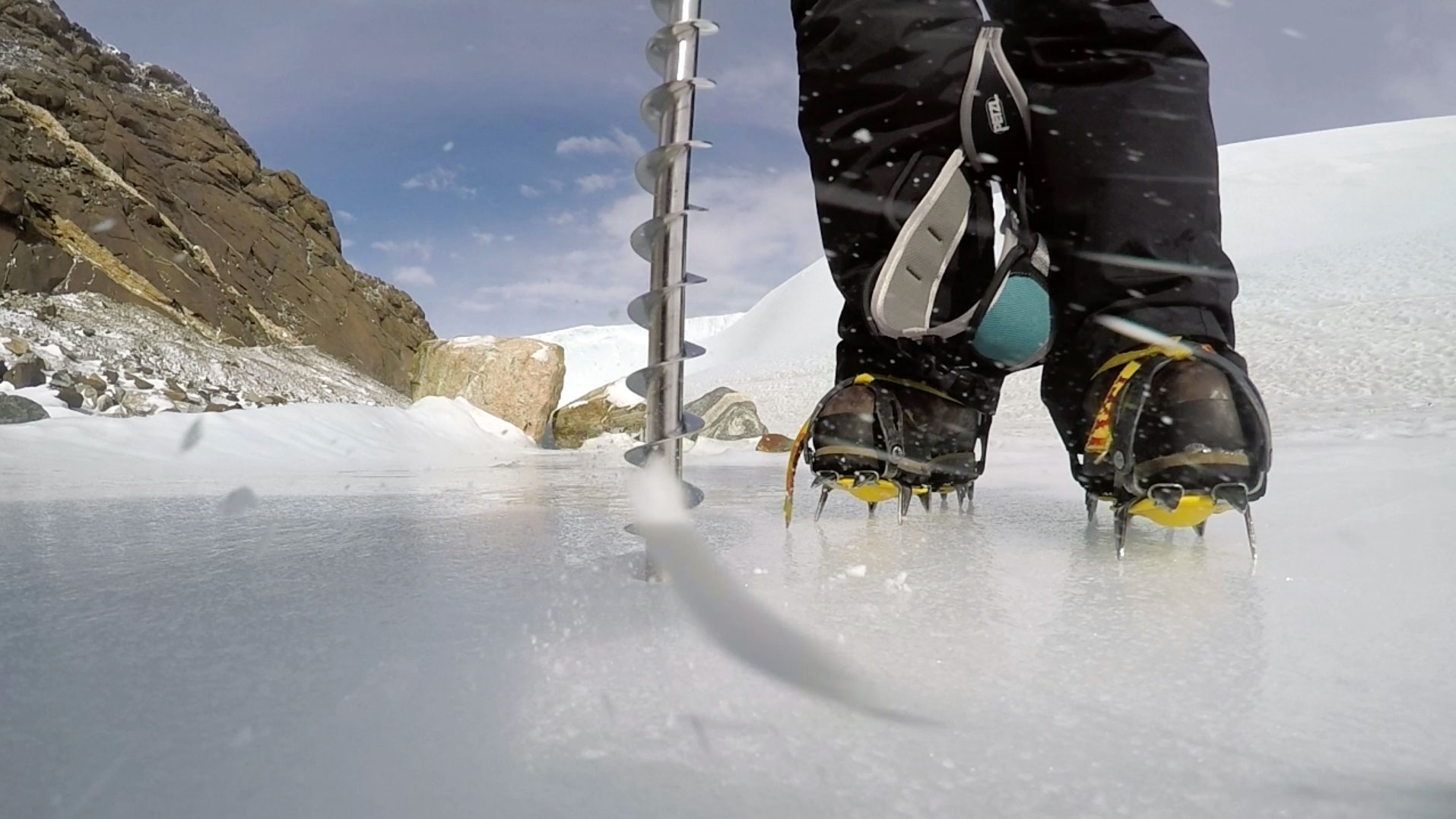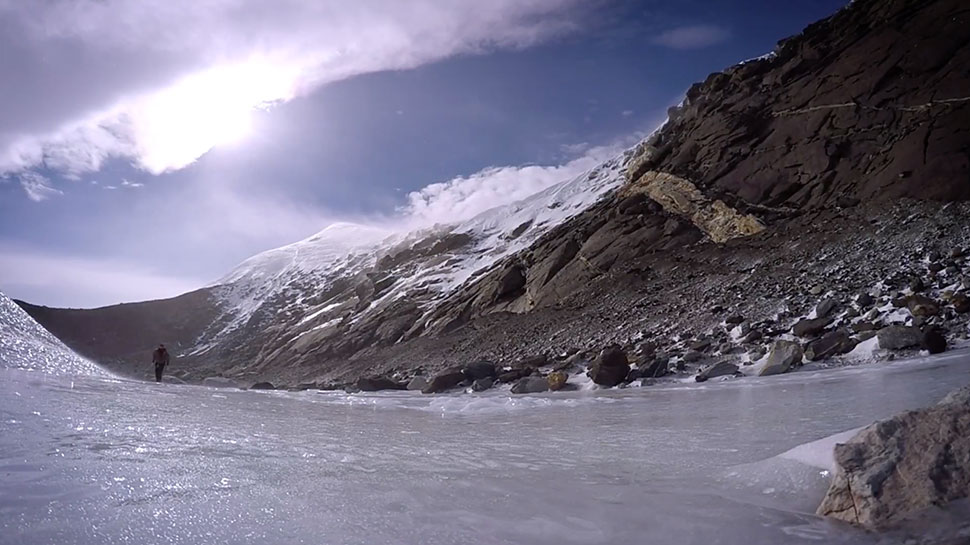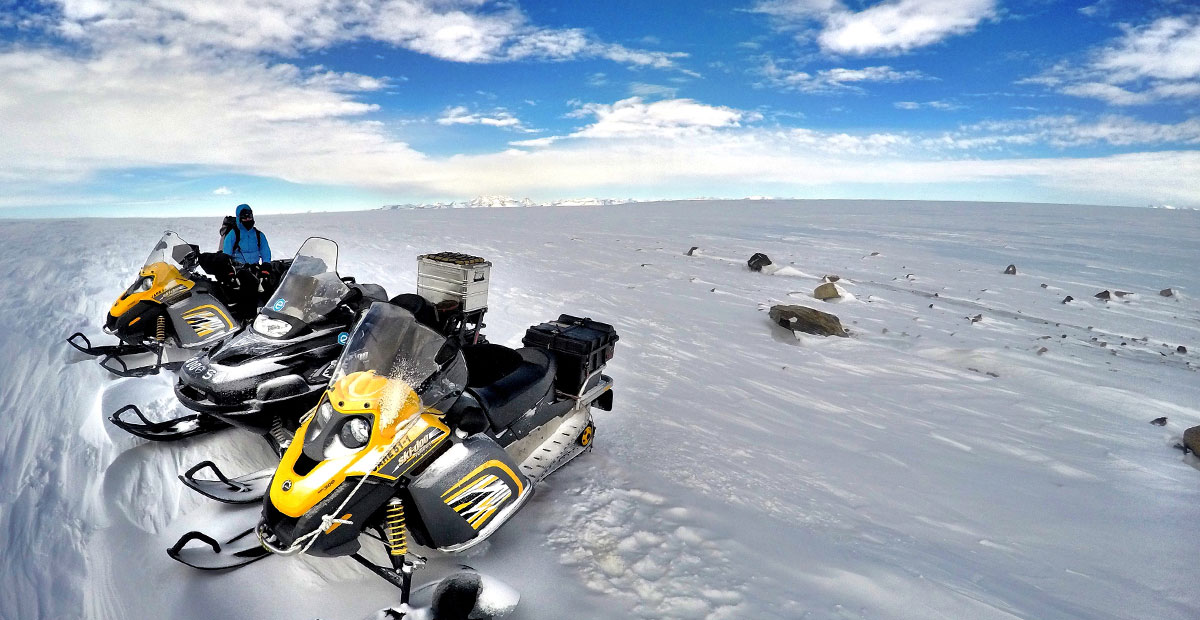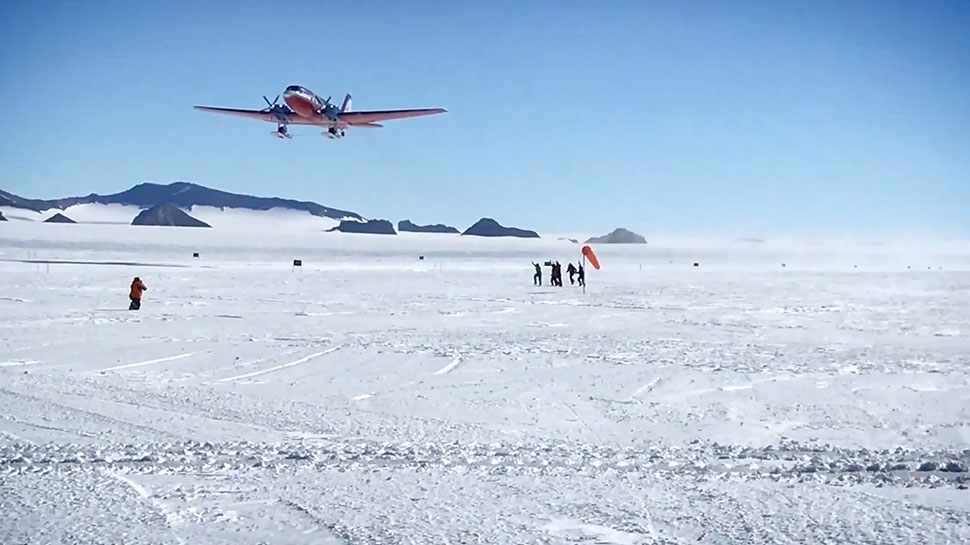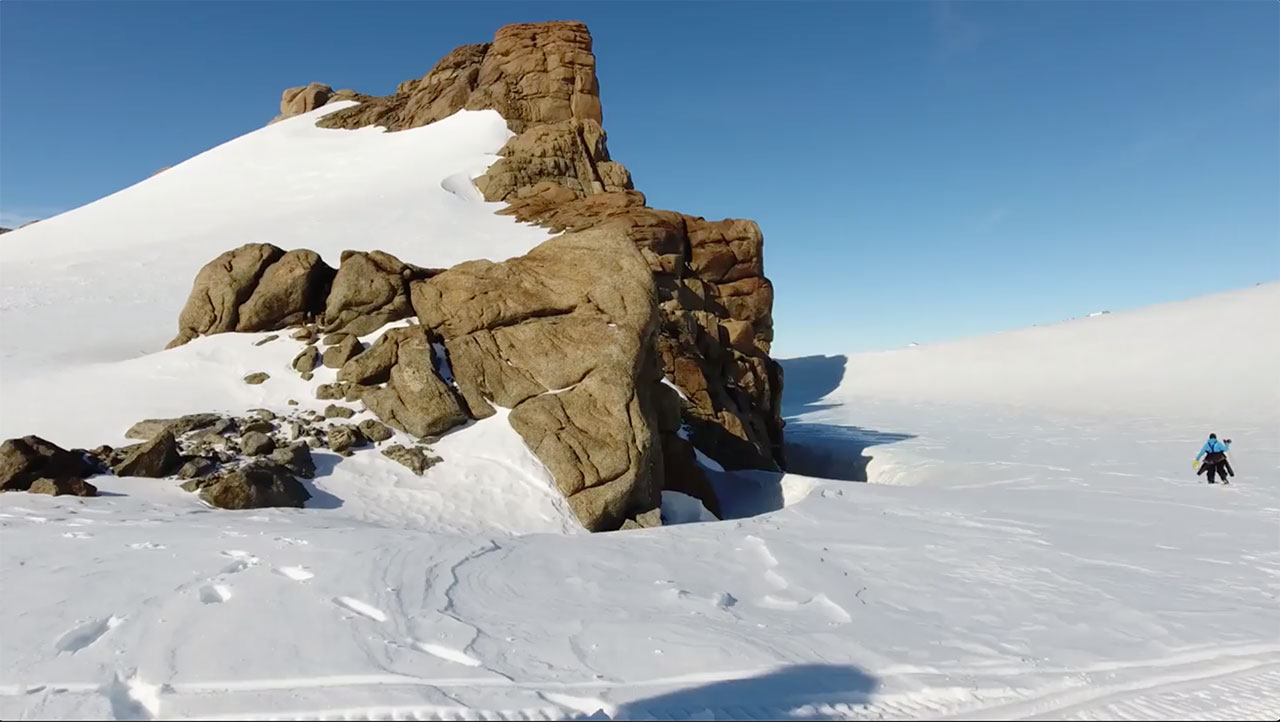PolarExplorer
Lori Ziolkowski’s research in Antarctica could affect everything from the study of climate change to the search for extraterrestrial life.
By Melinda Waldrop | Videos by Joshua Burrack
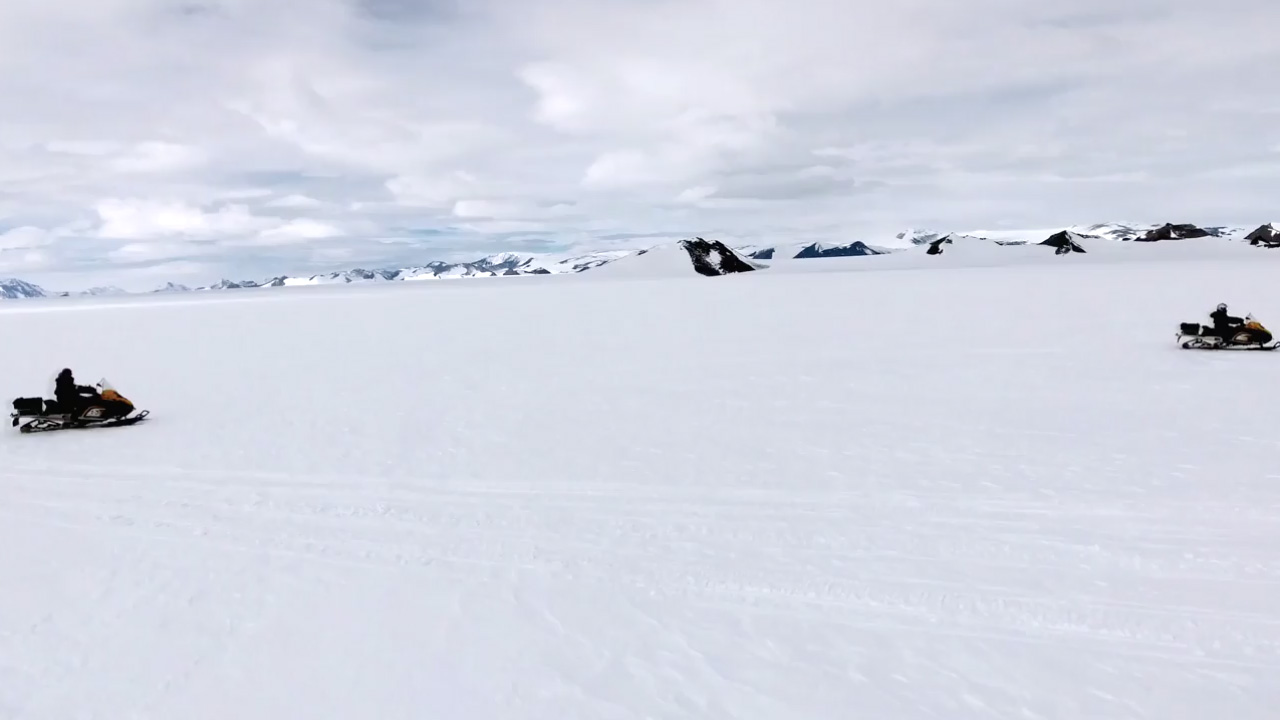
Video footage: People riding in skidoos across the snow in Antarctica
For a moment, Lori Ziolkowski stood alone on the ice.
Ziolkowski, an assistant professor in the University of South Carolina’s School of the Earth, Ocean and Environment, spent a month this past winter in Antarctica, searching for life at the bottom of the world.
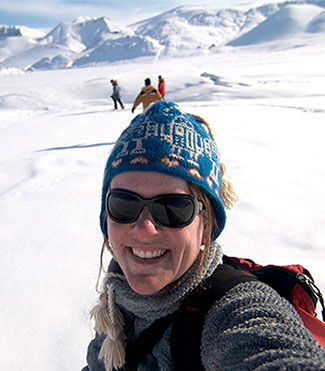
Lori Ziolkowski, an assistant professor in the School of the Earth, Ocean and Environment, traveled to Antarctica this past winter to study microbial life in extreme conditions. Not only did the research team collect samples hoping to find clues to the age of the carbon contained in the microbes, but members also documented the trip through photo and videos.
One day, on her way to collect a sample, she decided on a whim to grab a pair of skis from the isolated Belgian research station that served as home base.
“It was wild. I was by myself, skiing,” Ziolkowski says. Her destination wasn’t far from the station, “but just being by yourself in Antarctica is kind of weird.”
The first non-European recipient of the prestigious Baillet Latour Fellowship, awarded by the International Polar Foundation, Ziolkowski joined an international team on the trail of microbes. The 17 scientists sought evidence of microbial activity and carbon accumulation that could have ramifications for everything from the study of climate change to the search for life in outer space.
In awarding Ziolkowski the fellowship, a panel of international microbiology experts lauded her proposal as “excellent, well-planned, novel and feasible” and “led by a very well-qualified and knowledgeable applicant.” Ziolkowski will return to Antarctica in December for the second leg of the two-year grant to continue looking for life in extreme conditions.
Ziolkowski specializes in radiocarbon dating of compounds to measure life cycles and address environmental concerns, and her work has taken her to Alaskan glaciers and across the Canadian Arctic. But nothing struck her — or her friends and colleagues — quite as much as standing on a vast sheet of frozen ice, sunlight glinting in every direction, at the edge of a still-mysterious continent.
“I have never done anything that captured so many people’s curiosity,” she says.
Back in her lab at Carolina, Ziolkowski will spend the summer examining samples of water, rock and algae, searching for clues to the age of the carbon contained in the microbes.
If microbes can live on a rock in extreme conditions in Antarctica, they could also perhaps exist on, say, Mars, and information gleaned from the Arctic microbes could inform efforts to find their extraterrestrial kin.
“I’d be pleased to find abundant life in these samples, just because it’s such a harsh environment that you don’t expect to find life there,” she says. “I came back with enough samples that we could get many papers out of what we’ve collected so far.”
Ice-breaking Research
The lake was a completely unexpected find.
One morning, Ziolkowski and German collaborating scientist Steffi Lutz headed out for what they thought would be a routine day of drilling into one of Antarctica’s many subglacial lakes to collect water samples. Temperatures had not risen above freezing during the Antarctic summer, so the scientists — as well as the longtime director of the Princess Elisabeth polar research station — were astonished to come upon a body of open, flowing water.
“You’re in the middle of an ice sheet and there’s this lake,” Ziolkowski says.
Floating in the water were large chunks of algae that would have been inaccessible underneath the ice. Stirring the water produced green particles Ziolkowski believes contain cyanobacteria — aquatic, photosynthetic organisms that, at more than 3.5 billion years old, have played a major role in ecological evolution. They changed the chemistry of the atmosphere during Archaean and Proterozoic eras, making it more suitable for life. The chloroplast plants use to make food is actually a cyanobacterium living within the plant’s cells.
As exciting as its discovery was, the cyanobacteria may just be the tip of a warming iceberg.
“It’s made me curious. Are there other lakes that perhaps have not been seen before?” Ziolkowski says. “While this work is much more about what life exists there, climate change is happening.”
Ziolkowski and her team also analyzed soil, moss and lichen. “We tried looking for microbes living in rocks,” she says. “Microbes often live just below the surface, out of the wind. They won’t be dried, and they can retain moisture. It’s just a way to have a better habitat. They live just a little bit below the surface so they still can get light, so they’re still photosynthesizing.”
Ziolkowski believes she’ll find evidence of microbes living in the samples she collected. The key is to understand what kind of organisms are there and how active they are. In a blog she updated while in Antarctica, Ziolkowski explained her research as though talking to her international colleagues:
“One way we described this to the multi-national, multi-lingual station is that we are trying to figure out how many Belgians, French, Germans and Italians live at the station, and who is moving the most,” Ziolkowski wrote. “Are the microbes simple communities of just a few species or a cosmopolitan mixture of organisms that live together? Are the microbes cycling slowly on the timescale of decades, or more quickly, like their temperate counterparts?”
Post-trip, Ziolkowski says: “Based on visual observation, they’re there, but it’s just the idea of, how quickly are they processing? How quickly are they metabolizing? In different places of Antarctica, people have looked at microbes living in rocks and thought that they were cycling by thousand-year time scales, whereas here, they would be like a month.”


The speed of microbe carbon cycling has countless implications. Ziolkowski’s study of carbon cycling years after the Deepwater Horizon oil spill showed microbes still eating the remnants of the oil — a finding that could influence pollution remediation efforts.
In Antarctica, Ziolkowski also examined moss with striking color variations she thinks are pigment light adaptations to the continent’s omnipresent sun as well as metamorphic rock — pieces of what was once seafloor excavated in the collision of Antarctic and African continental plates.
Ziolkowski’s extensive research travels have also taken her to the Alaskan tundra, where she’s sampled permafrost to determine how much the thawing, carbon-rich soil contributes to greenhouse gases. She’s also studied permafrost in Svalbard, an archipelago between Norway and the North Pole, and spent 300 days at sea.
“I’m motivated by the implications for climate change, but also, who gets to do a job where you’re doing something that’s fun and adventurous but also helping understand what’s going to happen in the future?” she says. “It makes me feel like I’m doing something worthwhile in the grand scheme of things.”
Extreme Conditions
While Ziolkowski didn’t travel very far from the Princess Elisabeth station, the small mountain range the station is situated in contributed to great variation in the geography she saw.
This was starkly illustrated when members of the team visited a northern windscoop — a deep valley of snow formed when strong winds shear off elevated rock formations called nunataks, shoveling pockets of snow to the side in their wake.
“We could have been somewhere where it was just flat ice and boring,” Ziolkowski says. “But what made it more unique was the small mountain range.”
At the windscoop near the northern-most point the team ventured to, temperatures dipped to minus-30 degrees Celsius as the wind howled. After having to quickly remove her glove, Ziolkowski was rewarded with an aching fingertip for the rest of the day.
“That was a good lesson,” she says. “We almost got frostbite that day. But it was super cool.”
Despite dogged efforts, however, the team could not obtain viable samples in the thicker ice at the windscoop.
Video footage: Strong wind blowing snow and ice on the ground in Antarctica.
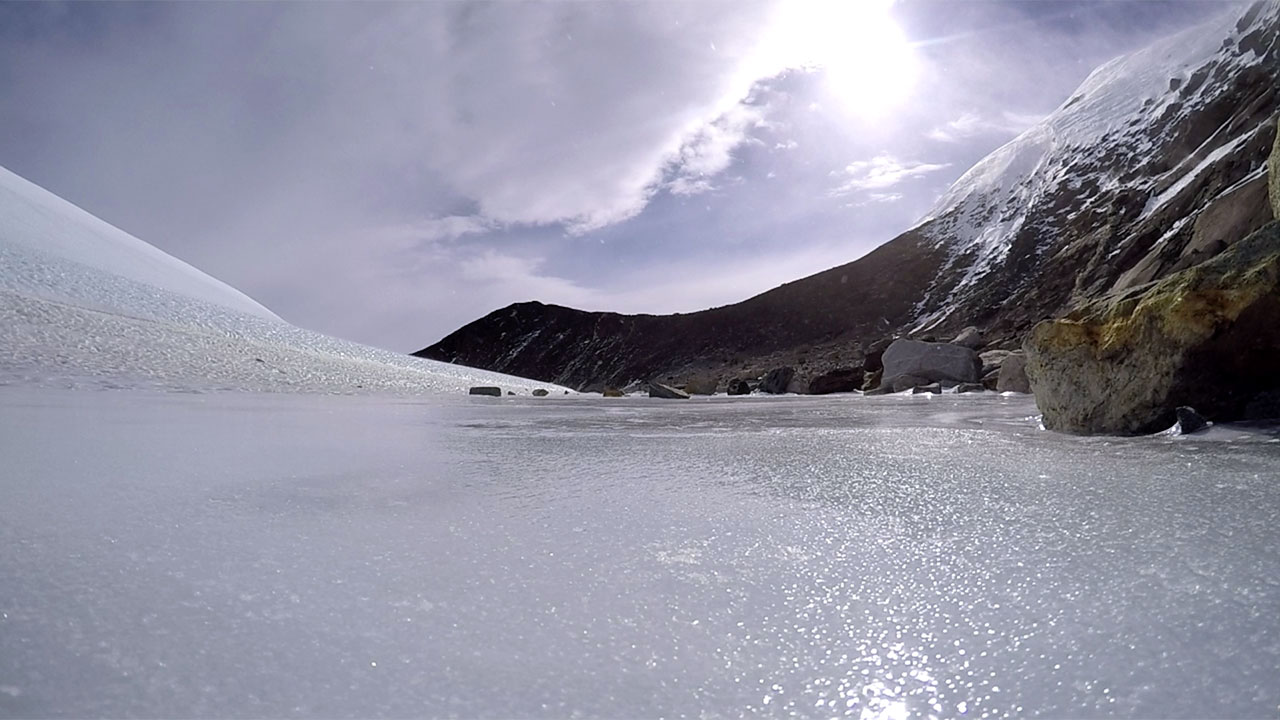
Antarctica Summers
Average High: -31° F
Average Low: -42° F
Average Wind Speed: 11 mph
In near-whiteout conditions, the scientists were grateful to have the radios and the GPS devices they never left the station without. The theory was, someone could call and give coordinates to would-be rescuers if trouble arose. Team members also completed crevasse safety training before being allowed to venture any distance from the station.
“We had to learn how to rescue someone if they fell down a crack in the ice,” Ziolkowski says. “That also meant that every person had to go down into a crack in the ice and be rescued. It was kind of wild. You just met these people, but you have to trust them to get you out of there. I was probably down 30 to 35 feet. It’s super quiet. It had a very peaceful quality to it.”
The scientists traveled most often by snow machines known as Ski-Doos, skimming across the ice to reach sampling sites. Ziolkowski amused herself shooting drone footage of the Ski-Doos, using her iPhone when her iPad froze up — though the potential dangers of their research locale were never far from mind.
“There was one day when we were about an hour away from the station and the field guide crossed a crevasse,” Ziolkowski says. “It was only once he crossed it that he was like, ‘Oh, that’s a crevasse. Don’t go there.’ Then we traveled parallel to each other with the crevasse between us, communicating with hand signals because you can’t hear. Eventually, we crossed.”
Daily Life
The Belgian station where Ziolkowski spent a month living with 16 other people had a distinctly French flair, from the language most fluently spoken to the chocolate croissants flown in from a Brussels bakery.
Getting to the station was a journey in itself, beginning with a 16-hour flight from Atlanta to Johannesburg, South Africa, and then another two hours to Cape Town in mid-January. After a few days of mobilizing and meeting her fellow scientists, Ziolkowski boarded a Russian cargo plane on a 90-degree day, duffel bag containing the winter clothes she would need in six hours in hand.
“We landed at four in the morning, and it was bright, bright sunshine,” she says. “There were no clouds in the sky and it probably 10 below zero, in Celsius. You just always had to wear your sunglasses, because even on a cloudy day, the sun was out. The sun never set the whole time I was there.”
A small plane, an old DC-3 piloted by native Canadians like Ziolkowski, then ferried the scientists to their ultimate destination.
A French chef cooked for the team members. Everyone also spoke English, and Ziolkowski learned some French growing up in Canada, but she plans to take a French class this summer to brush up on her communication skills.
“There were a lot of French specialties,” she says. “They were upset because the only chocolate we had was Cadbury. American stations are very utilitarian. This station had some nice luxuries, and so it made the whole experience far more comfortable.”
Ziolkowski shared a room with bunk beds and without windows with Lutz. The scientists noshed on cold cuts and cheese — in addition to the croissants — for breakfast and had salads, soup or pizza for lunch. Dinners were more of a potluck affair, with crew members taking turns cooking on Sundays.
“I took a picture of every meal that I was at the station for, just because I was curious to watch the progression of the colors over the month,” Ziolkowski says. “When you arrive, you bring food. There were boxes of food that came with us from Cape Town. And so we had salads at first, and fresh herbs. But by the end of the month, it was red cabbage and frozen things. It’s all that you have left.”
When Ziolkowski returns in December, she hopes to be at the station for a crew change, to see how an infusion of new people changes the social and cultural dynamics.
At the end of her stay, the Canadian pilots returned to collect the departing scientists, and Ziolkowski chattered away with them in rapid-fire English while those remaining at the station chased after the plane, waving exaggerated goodbyes.
Anticipated Return
Ziolkowski waited a while to study her collected samples once she returned from the ice of the Antarctic to the famous heat of Columbia. Careful measures had to be taken to ensure there was no contamination of those samples from the bevy of biologists who have previously trekked across the continent.
With DNA already extracted and sent off for analysis, Ziolkowski began delving into her research bounty the first week of June.
“We found lots of different types of life, as well as different habitats, or places where life could grow,” she says. “It would be really nice to see that there would be lots of life around. That also means that when you get more warming somewhere like Antarctica, you could have more life forming, and you could have more accumulation of carbon within the soils. That means that we should also find signatures of life that was once there in past warm times.”
Ziolkowski has already begun making her field plan for her return trip in December. This time, she wants to go camping on the Antarctic ice.
“I’ve been talking to the Belgians about how to go about that and where to go. We’ve been talking about where to travel, and I’m trying to negotiate with them to do a camping trip because it can allow us to go places that aren’t accessible in a day trip,” she says. “There’s a big collision zone where an Antarctic plate and an African plate collide, so it really changes the geology. Maybe there’s some differences in the samples we’d find because of that.”
Ziolkowski is also excited about the possibility of finding another open lake. She hopes the knowledge gleaned from her first trip will help direct and focus her research during her second Antarctic voyage.
“I really look forward to going back. It was an amazing experience,” she says. “I had a lot of fear before going. I was quite anxious. But now I’m just like, it’s an adventure, and I can’t wait to go again.”
